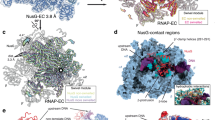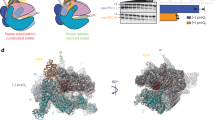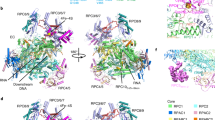Abstract
Tagetitoxin (Tgt) inhibits transcription by an unknown mechanism. A structure at a resolution of 2.4 Å of the Thermus thermophilus RNA polymerase (RNAP)–Tgt complex revealed that the Tgt-binding site within the RNAP secondary channel overlaps that of the stringent control effector ppGpp, which partially protects RNAP from Tgt inhibition. Tgt binding is mediated exclusively through polar interactions with the β and β′ residues whose substitutions confer resistance to Tgt in vitro. Importantly, a Tgt phosphate, together with two active site acidic residues, coordinates the third Mg2+ ion, which is distinct from the two catalytic metal ions. We show that Tgt inhibits all RNAP catalytic reactions and propose a mechanism in which the Tgt-bound Mg2+ ion has a key role in stabilization of an inactive transcription intermediate. Remodeling of the active site by metal ions could be a common theme in the regulation of catalysis by nucleic acid enzymes.
This is a preview of subscription content, access via your institution
Access options
Subscribe to this journal
Receive 12 print issues and online access
$189.00 per year
only $15.75 per issue
Buy this article
- Purchase on Springer Link
- Instant access to full article PDF
Prices may be subject to local taxes which are calculated during checkout





Similar content being viewed by others
References
Rozovskaia, T., Chenchik, A. & Bibilashvili, R. Reaction of pyrophosphorolysis catalyzed by Escherichia coli RNA polymerase. Mol. Biol. (Mosk.) 15, 636–652 (1981).
Sosunov, V. et al. Unified two-metal mechanism of RNA synthesis and degradation by RNA polymerase. EMBO J. 22, 2234–2244 (2003).
Komissarova, N. & Kashlev, M. Transcriptional arrest: Escherichia coli RNA polymerase translocates backward, leaving the 3′ end of the RNA intact and extruded. Proc. Natl. Acad. Sci. USA 94, 1755–1760 (1997).
Orlova, M., Newlands, J., Das, A., Goldfarb, A. & Borukhov, S. Intrinsic transcript cleavage activity of RNA polymerase. Proc. Natl. Acad. Sci. USA 92, 4596–4600 (1995).
Steitz, T.A. A mechanism for all polymerases. Nature 391, 231–232 (1998).
Vassylyev, D.G. et al. Crystal structure of a bacterial RNA polymerase holoenzyme at 2.6 Å resolution. Nature 417, 712–719 (2002).
Zhang, G. et al. Crystal structure of Thermus aquaticus core RNA polymerase at 3.3 Å resolution. Cell 98, 811–824 (1999).
Artsimovitch, I. et al. Structural basis for transcription regulation by alarmone ppGpp. Cell 117, 299–310 (2004).
Cramer, P. Structure and function of RNA polymerase II. Adv. Protein Chem. 67, 1–42 (2004).
Lukens, J.H. & Durbin, R.D. Tagetitoxin affects plastid development in seedling leaves of wheat. Planta 165, 311–321 (1985).
Mathews, D.E. & Durbin, R.D. Tagetitoxin inhibits RNA synthesis directed by RNA polymerases from chloroplasts and Escherichia coli. J. Biol. Chem. 265, 493–498 (1990).
Mathews, D.E. & Durbin, R.D. Mechanistic aspects of tagetitoxin inhibition of RNA polymerase from Escherichia coli. Biochemistry 33, 11987–11992 (1994).
Steinberg, T.H., Mathews, D.E., Durbin, R.D. & Burgess, R.R. Tagetitoxin: a new inhibitor of eukaryotic transcription by RNA polymerase III. J. Biol. Chem. 265, 499–505 (1990).
Temiakov, D. et al. Structural basis of transcription inhibition by antibiotic streptolydigin. Mol. Cell 19, 655–666 (2005).
Artsimovitch, I. et al. Allosteric modulation of the RNA polymerase catalytic reaction is an essential component of transcription control by rifamycins. Cell 122, 351–363 (2005).
Svetlov, V., Vassylyev, D.G. & Artsimovitch, I. Discrimination against deoxyribonucleotide substrates by bacterial RNA polymerase. J. Biol. Chem. 279, 38087–38090 (2004).
Westover, K.D., Bushnell, D.A. & Kornberg, R.D. Structural basis of transcription: nucleotide selection by rotation in the RNA polymerase II active center. Cell 119, 481–489 (2004).
Zhou, Y.N. & Jin, D.J. The rpoB mutants destabilizing initiation complexes at stringently controlled promoters behave like “stringent” RNA polymerases in Escherichia coli. Proc. Natl. Acad. Sci. USA 95, 2908–2913 (1998).
Jin, D.J. & Gross, C. Mapping and sequencing of mutations in the Escherichia coli rpoB gene that lead to rifampicin resistance. J. Mol. Biol. 202, 45–58 (1988).
Yuzenkova, J. et al. Mutations of bacterial RNA polymerase leading to resistance to microcin J25. J. Biol. Chem. 277, 50867–50875 (2002).
Artsimovitch, I., Chu, C., Lynch, A.S. & Landick, R. A new class of bacterial RNA polymerase inhibitor affects nucleotide addition. Science 302, 650–654 (2003).
Adelman, K. et al. Molecular mechanism of transcription inhibition by peptide antibiotic microcin J25. Mol. Cell 14, 753–762 (2004).
Mukhopadhyay, J., Sineva, E., Knight, J., Levy, R.M. & Ebright, R.H. Antibacterial peptide microcin J25 inhibits transcription by binding within and obstructing the RNA polymerase secondary channel. Mol. Cell 14, 739–751 (2004).
Opalka, N. et al. Structure and function of the transcription elongation factor GreB bound to bacterial RNA polymerase. Cell 114, 335–345 (2003).
Laptenko, O., Lee, J., Lomakin, I. & Borukhov, S. Transcript cleavage factors GreA and GreB act as transient catalytic components of RNA polymerase. EMBO J. 22, 6322–6334 (2003).
Perederina, A. et al. Regulation through the secondary channel–structural framework for ppGpp-DksA synergism during transcription. Cell 118, 297–309 (2004).
Paul, B.J. et al. DksA: a critical component of the transcription initiation machinery that potentiates the regulation of rRNA promoters by ppGpp and the initiating NTP. Cell 118, 311–322 (2004).
Artsimovitch, I. & Landick, R. The transcriptional regulator RfaH stimulates RNA chain synthesis after recruitment to elongation complexes by the exposed nontemplate DNA strand. Cell 109, 193–203 (2002).
Steinberg, T.H. & Burgess, R.R. Tagetitoxin inhibition of RNA polymerase III transcription results from enhanced pausing at discrete sites and is template-dependent. J. Biol. Chem. 267, 20204–20211 (1992).
Kettenberger, H., Armache, K.J. & Cramer, P. Complete RNA polymerase II elongation complex structure and its interactions with NTP and TFIIS. Mol. Cell 16, 955–965 (2004).
Armache, K.J., Kettenberger, H. & Cramer, P. The dynamic machinery of mRNA elongation. Curr. Opin. Struct. Biol. 15, 197–203 (2005).
Temiakov, D. et al. Structural basis for substrate selection by T7 RNA polymerase. Cell 116, 381–391 (2004).
Yin, Y.W. & Steitz, T.A. The structural mechanism of translocation and helicase activity in T7 RNA polymerase. Cell 116, 393–404 (2004).
Yang, L., Arora, K., Beard, W.A., Wilson, S.H. & Schlick, T. Critical role of magnesium ions in DNA polymerase β's closing and active site assembly. J. Am. Chem. Soc. 126, 8441–8453 (2004).
Nowotny, M., Gaidamakov, S.A., Crouch, R.J. & Yang, W. Crystal structures of RNase H bound to an RNA/DNA hybrid: substrate specificity and metal-dependent catalysis. Cell 121, 1005–1016 (2005).
Kettenberger, H., Armache, K.J. & Cramer, P. Architecture of the RNA polymerase II-TFIIS complex and implications for mRNA cleavage. Cell 114, 347–357 (2003).
Sosunova, E. et al. Donation of catalytic residues to RNA polymerase active center by transcription factor Gre. Proc. Natl. Acad. Sci. USA 100, 15469–15474 (2003).
Artsimovitch, I., Svetlov, V., Anthony, L., Burgess, R.R. & Landick, R. RNA polymerases from Bacillus subtilis and Escherichia coli differ in recognition of regulatory signals in vitro. J. Bacteriol. 182, 6027–6035 (2000).
Otwinowski, Z. & Minor, W. Processing X-ray diffraction data collected in oscillation mode. Methods Enzymol. 276, 307–326 (1997).
Brünger, A.T. et al. Crystallography & NMR system: a new software suite for macromolecular structure determination. Acta Crystallogr. D 54, 905–921 (1998).
Jones, T.A., Zou, J.Y., Cowan, S.W. & Kjeldgaard, M. Improved methods for building protein models in electron density maps and the location of errors in these models. Acta Crystallogr. A 47, 110–119 (1991).
Kraulis, P.J. MOLSCRIPT: a program to produce both detailed and schematic plots of protein structures. J. Appl. Crystallogr. 24, 946–950 (1991).
Esnouf, R.M. Further additions to MolScript version 1.4, including reading and contouring of electron-density maps. Acta Crystallogr. D 55, 938–940 (1999).
Merrit, E.A. & Bacon, D.J. Raster3D: photorealistic molecular graphics. Methods Enzymol. 277, 505–524 (1997).
Acknowledgements
We thank R. Landick and J. Roberts for helpful comments. This work was supported by grants GM74252 and GM74840 (to D.G.V.) and GM67153 (to I.A.) from the US National Institutes of Health, and by RIKEN (D.G.V.).
Author information
Authors and Affiliations
Corresponding authors
Ethics declarations
Competing interests
The authors declare no competing financial interests.
Supplementary information
Supplementary Fig. 1
Tgt inhibits transcription by the E. coli and T. thermophilus RNAPs similarly (PDF 220 kb)
Supplementary Fig. 2
Comparison with the eukaryotic enzymes (PDF 120 kb)
Supplementary Fig. 3
Tgt acts as an uncompetitive inhibitor. (PDF 114 kb)
Supplementary Table 1
Plasmids and oligonucleotides used in this work (PDF 37 kb)
Rights and permissions
About this article
Cite this article
Vassylyev, D., Svetlov, V., Vassylyeva, M. et al. Structural basis for transcription inhibition by tagetitoxin. Nat Struct Mol Biol 12, 1086–1093 (2005). https://doi.org/10.1038/nsmb1015
Received:
Accepted:
Published:
Issue Date:
DOI: https://doi.org/10.1038/nsmb1015
This article is cited by
-
Prospects for new antibiotics: a molecule-centered perspective
The Journal of Antibiotics (2014)
-
Comparative whole genome sequence analysis of wild-type and cidofovir-resistant monkeypoxvirus
Virology Journal (2010)
-
An allosteric mechanism of Rho-dependent transcription termination
Nature (2010)
-
Transcription inactivation through local refolding of the RNA polymerase structure
Nature (2009)



